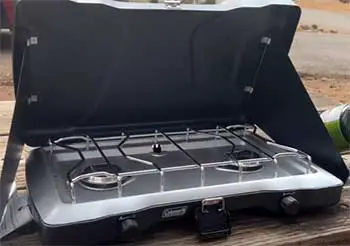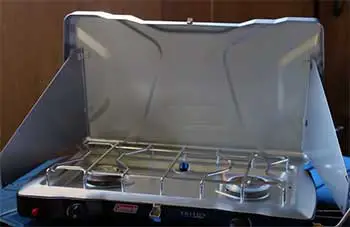When it comes to camp stoves, Coleman is one of the most well-known and trusted brands among outdoor enthusiasts. Two of their popular portable stove models are the Triton and Triton Plus.
Both stoves are proven performers, but they have some key differences that prospective buyers should consider. This comprehensive guide compares the Triton and Triton Plus side-by-side on metrics like boil time, wind blocking, adjustability, ease of setup, and more.
Stove Comparison Table
| Specs | Triton | Triton Plus |
| Weight | 4.1 lbs | 5 lbs |
| BTUs | 11,000 | 22,000 |
| Number of Burners | 2 | 2 |
| Wind Block Panels | No | Yes |
| Runtime @ High | 1.25 hours | 2.5 hours |
| Boil Time – 1 Quart Water | 4.5 minutes | 3.5 minutes |
| Adjustable Burner | No | Yes |
| InstaStart Ignition | No | Yes |
As shown in the table, the Triton Plus edges out the standard Triton in several areas like BTUs, wind resistance, boil time, and convenience features.
However, the Triton remains a compelling option for backpackers and minimalists due to its lighter body weight. The following sections expand on the pros and cons of each stove.
Triton Stove Pros
The standard Coleman Triton is a time-tested backpacking stove known for its reliability and performance. Here are some of the factors that make it a popular choice:

- Lightweight and portable: At just 4.1 pounds, the Triton stove can easily fit into a backpack without adding too much heft. This makes it a favorite among ultralight hikers who want a proven stove without extra bulk.
- Decent power for the size: With 11,000 BTUs of cooking power, the Triton delivers enough heat to boil a quart of water in around 4.5 minutes. While not the fastest boiling stove out there, it gets the job done quickly for a portable 2-burner model.
- Simple and durable: With no electronic ignition or complex wind block systems, the Triton has fewer parts that can break. Its simple adjustable knobs and rugged build quality allow it to stand up well to frequent transport and outdoor use.
- Compatible with disposable green canisters: In addition to small propane tanks, the Triton can connect directly to 16-ounce disposable green fuel canisters. This gives buyers more fuel flexibility for longer trips.
- Budget-friendly price: As one of Coleman’s most affordable full-sized camping stoves, the Triton offers great value at around $65 MSRP. Its low cost makes it accessible even to price-conscious outdoor lovers.
In short, the Coleman Triton stove excels at delivering no-fuss performance and portability without breaking the bank. For backpackers doing short trips, it remains a perfectly capable workhorse.
Also Read: How Jetboil Sumo And MiniMo Stoves Stack Up?
Triton Cons
Despite being a trusty backcountry cooker, the standard Triton isn’t without a few downsides:

- Lacks wind block protection: With no protective barrier around the burners, the Triton’s flame is more prone to blowing out in windy conditions above 10 MPH. This can lead to frustrating flameouts when weather kicks up.
- Heavy compared to ultralight stoves: At over 4 pounds, the Triton may be too hefty for ultralight hikers who try to cut every ounce possible out of packs. More portable alcohol and canister stoves are under 1 pound.
- Slower boil times: Boiling a liter of water in 4.5 minutes is respectable but slower than higher-powered jets. Serious camp chefs may want a stove that brings water to a bubble faster.
- No matchless ignition: The need to light the Triton with matches or a lighter introduces a small point of failure risk. Stoves with push-button ignition remove this hassle.
- Less precise simmer control: With only basic adjustable knobs and spread-out burners, finely tuning a simmer can be trickier compared to stoves with brighter/dimmer controls.
While the standard Coleman Triton gets the basic camping cooking jobs done, its lack of wind resistance and slower boil times leave room for improvement. This is where the upgraded Triton Plus comes in.
Triton Plus Pros
Building on the Triton’s proven design, the Triton Plus adds several bonus features to create an even more versatile camping stove. Some of its best selling points include:

- Faster boil times: With 22,000 BTUs spread evenly across two burners, the Triton Plus has nearly double the peak power. This allows it to boil a full quart of water a full minute faster than the regular Triton.
- Windblock panels for better wind resistance: The Triton Plus surrounds its burners with protective wind panels on three sides. This allows the flames to better withstand breezy conditions up to 15 MPH.
- Push-button InstaStart ignition: An integrated electric starter lets owners fire up the Triton Plus burners by simply pushing a button – no matches required. This is a great convenience bonus.
- Adjustable burner knobs with fine simmer control: Dial knobs on the Plus model allow cooks to finely tune the flame height for controlled simmering. This helps when cooking foods that need delicate heating.
- More runtime per tank: At maximum flame, the Triton Plus can squeeze out around 2.5 hours of burn time from a 16-ounce propane cylinder, beating the Triton’s 1.25 hours.
Thanks to bonuses like faster boil times, better wind resistance, and more precise adjustability, the upgraded Triton Plus is the clear choice for car campers and RV owners who want excellent performance. It makes cooking hearty camp meals a breeze.
Triton Plus Cons
There are only a few downsides associated with stepping up to the souped-up Triton Plus stove:
- Heavier: Thanks to its more complex wind block structure and electric starter, the Triton Plus tips the scales at 5 pounds total. This puts it out of reach for strict ultralight backpackers.
- More parts means more things that can break: With push-button ignition, battery packs, and adjustable valves, the Triton Plus understandably has more components that could potentially fail after years of hard use. However the build quality is quite robust.
- Higher price tag: The extra features of the Plus model add to its cost, with an MSRP around $115. Casual car campers may not want to spend the premium if they won’t use the bonus perks often.
- Overkill for simple boiling tasks: For basecamp campers who only need occasional water boiling, the standard Triton gets the job done fine at a lower price and weight.
Thus for certain users like thru-hikers and minimalists, the standard Triton hits the sweet spot of being a time-tested performer without complex extras that could break. But the Triton Plus remains the top choice for avid camp chefs.
Also Read: How Jetboil Sumo And Flash Stove Stack Up?
Frequently Asked Questions (FAQ)
Both the standard Triton and Triton Plus measure 21.9 x 12.6 x 3.5 inches (LWH). So they have the same compact footprint and can fit on most camp tables.
The Coleman Triton Plus is the model that comes equipped with InstaStart push-button electric ignition. The standard Triton requires manual lighting with matches/lighter.
For over a century, Coleman has built a reputation for making dependable and affordable camping gear that delivers. Both their Triton and Triton Plus stoves offer great bang-for-buck performance. The Triton Plus does cost more upfront but justifies it with useful bonuses like wind blocks and faster boil times.
The Coleman Triton Plus can boil a quart of water in just 3 minutes 30 seconds, which is extremely fast for a portable 2-burner propane stove. Canister stoves from MSR and Jetboil featuring specialized flux rings can boil a liter in around 3 minutes when optimized, making them the fastest backyard and backpacking stoves. But they only fit small pots.
Final Thoughts
At the end of the day, Coleman still makes some of the best car camping and all-around portable stoves you can buy – including both the standard Triton and souped-up Triton Plus. The lighter and simpler Triton gives you that classic Coleman functionality in a transportable 4-pound body.
Stepping up to the Triton Plus nets conveniences like push-button ignition and wind blocking for just $50 more. Sure, higher-end backpacking stoves may beat both models on specialized metrics like shaving ounces or the absolute fastest boil time.
But for family campers who want timeless Coleman quality at a fair price, the Triton series hits the right balance of sturdy performance and reliability.


